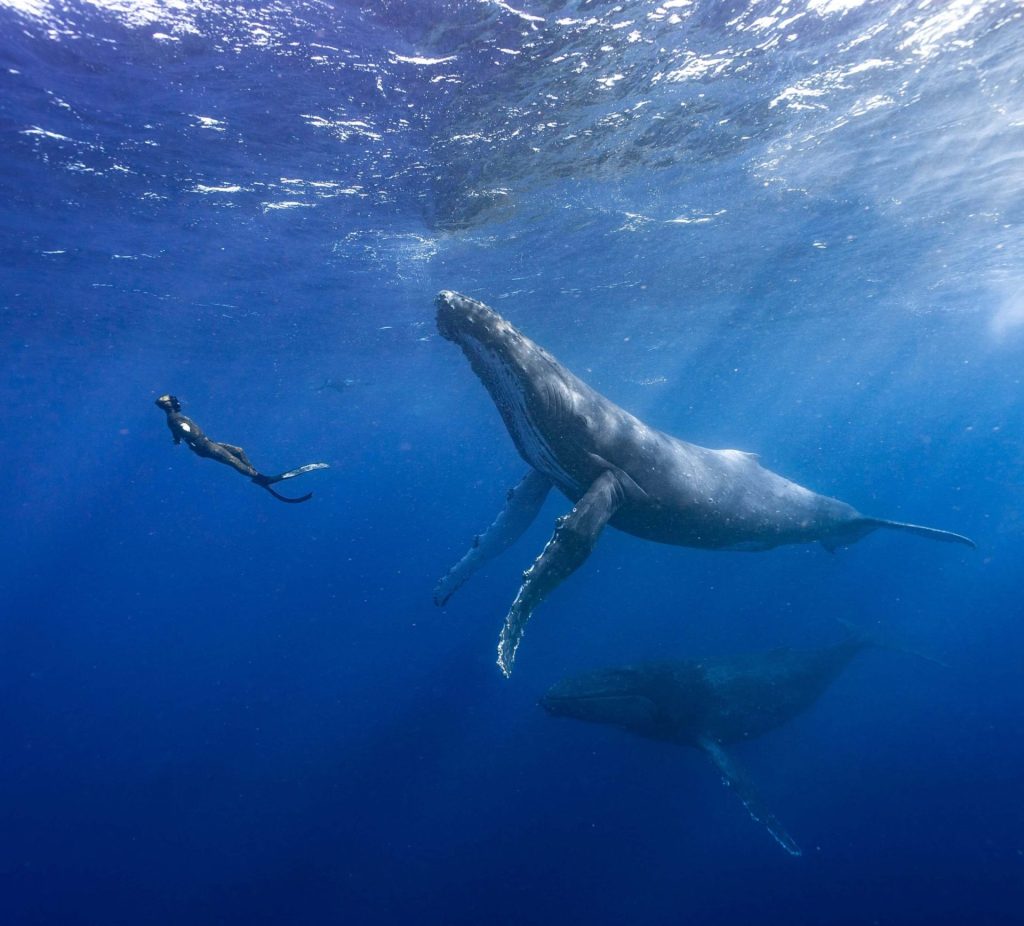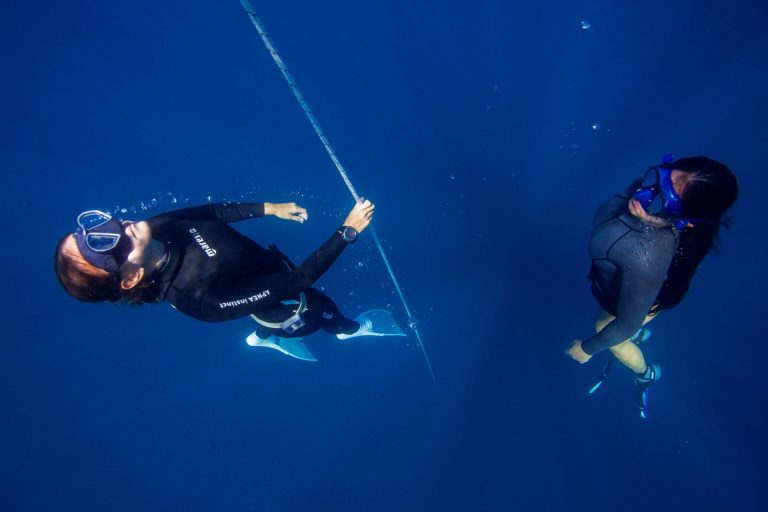What is Freediving: Exploring the Underwater Art and Sport

Brad Stephens ⋅ Updated: June 26, 2023

Table of Contents
What is freediving? It’s a thrilling underwater adventure that pushes human limits and explores the beauty of the ocean depths. This ancient form of diving, powered by breath-holding rather than equipment, offers an intimate connection with marine life and our own mental strength.
Freediving has many great benefits to our health and our daily life. We will cover some of the basics.
Competitive freedivers train extensively to master these skills and participate in international freediving competitions. But what gear do freedivers wear? And how do they ensure safety during their dives?
This post will delve into these aspects, and answer your question, what is freediving? While highlighting the benefits of this unique sport and emphasizing crucial safety considerations for divers. We’ll also explore various training methods used by professional freedivers worldwide.
What is Freediving?
Freediving, also known as breath-hold diving or skin diving, is exploring underwater without scuba gear. Instead, divers take a deep breath and descend into the water, exploring as long and far as possible before returning for air.
The Origins of Freediving
To answer, what is freediving? We must go back to its origins.
Freediving has a long and storied history, dating back thousands of years. Ancient civilizations such as the Greeks, Romans, and Egyptians practiced various forms of freediving for fishing, gathering pearls, and exploring the underwater world.
The Ama divers of Japan, known for their remarkable breath-holding abilities, have been diving without breathing apparatus for centuries. In recent times, the sport of freediving has gained popularity, with athletes pushing boundaries and setting records in disciplines like constant weight, free immersion, and static apnea. The history of freediving is rich with traditions and achievements, and its evolution continues to captivate the imagination of divers around the world.
Different Types of Freedives
- Static Apnea (STA): Hold your breath while floating on the surface of a pool for a time.
- Dynamic Apnea with bi-fins (DYNB): Swimming across a pool underwater with bi-fins for a distance.
- Dynamic Apnea with monofin (DYN): Swimming across a pool underwater with a monofin for a distance.
- Dynamic Apnea no fins (DNF): Swimming across a pool underwater without fins for a distance.
- Free Immersion (FIM): Using a rope to pull yourself down and up in the ocean for depth.
- Constant weight with bi-fins (CWTB): Using bi-fins to descend and ascend for depth.
- Constant weight with monofin (CWT): Using a monofin to descend and ascend for depth.
- Constant weight no fins (CNF): Swimming down and up without the use of fins for depth.
- Variable Weight (VWT): Typically using extra weights to go down quickly and then swimming back to the surface.
- No Limits (NLT): Anything goes – take a weighted sled down and have an assisted ascent with a lift bag.
The Equipment Used in Freediving
Unlike scuba diving, freediving requires minimal equipment. A basic set of equipment will include fins for propulsion, a mask and snorkel for visibility and breathing at the surface, a wetsuit for thermal protection, and a weight belt with weights to offset the buoyancy from your wetsuit.
“Explore the underwater world like never before with Freediving – just you, your breath, and no heavy equipment needed.”
Benefits of Freediving
Freediving isn’t just about holding your breath and diving deep. Freediving can be beneficial in many ways, not just for its eco-friendliness but also providing physical and mental advantages.
Physical Fitness
Freediving is a full-body workout that engages your core muscles, improves cardiovascular health, and increases endurance. Plus, it can improve your lung capacity and mobility over time.
Mental Wellbeing
Freediving encourages mindfulness and reduces stress levels by promoting relaxation and peace. It’s like meditation, but underwater.
Connection with Nature
Submerging in the ocean offers a direct encounter with marine life living in their native environment. It’s a unique experience that scuba gear can’t replicate due to noise pollution from air tanks. Imagine freediving in the crystal clear waters of Tonga with Humpback whales.

Competitive – Push Your Limits
Competitive freedivers push themselves both physically and mentally, aiming towards achieving greater depths on single breath holds. It’s a feat that demands discipline, training, dedication, and an exceptional skill set. Check out your country’s national records or world records – here
“Experience the ultimate full-body workout, mindfulness, and connection with nature through freediving.”
Techniques for Successful Freediving
Freediving requires physical strength and mental fortitude. To dive deeper and hold your breath longer, you need to master relaxation, breathing, and body awareness.
Relaxation is Key
To ensure a successful dive, it’s essential to keep your heart rate low and conserve oxygen by remaining tranquil. Utilizing some form of meditation to help calm your body and mind before a dive.
Breathe Like a Pro
Proper breathing exercises help you fill your lungs to maximum capacity and expel carbon dioxide efficiently.
Streamline Your Body
Streamlining reduces drag and saves energy and oxygen. Keep your body straight like an arrow with arms extended above your head or relaxed at you side to move smoothly through the water.
Master the Duck Dive
The duck dive technique involves bending your waist and pointing your fins towards the sky before using arm strength to push yourself downwards into the water column. Check out this guide on how to execute the perfect duck dive.
Use Your Fins Wisely
Slow and steady kicks provide better propulsion than frantic, fast ones. Learn about different types of finning styles commonly used by freedivers in this resource on finning technique.
Practice and patience are key to success in freediving. By mastering these techniques, you can make every dive a safer, longer, and more enjoyable experience.
Master relaxation, breathing & body positioning techniques to succeed in freediving. Streamline your body, use fins wisely & practice patience.
Safety First: Tips for Safe Freediving
Freediving is a thrilling activity, but it’s important to prioritize safety to avoid potential risks. Here are some tips to keep in mind:
Get the Right Gear
Don’t skimp on gear. Invest in quality equipment like a good mask, snorkel, fins, and wetsuit to protect yourself from underwater hazards. And don’t forget a dive computer to monitor your dive times and depths.

Buddy Up
Never dive alone. Find a partner who is prepared to respond swiftly in an unexpected situation. They could save your life.
Know Your Limits
Avoid exceeding your capabilities or venturing beyond what you are confident with; stay aware of hypoxia symptoms and conditions that don’t support diving, while keeping yourself in shape. Be aware of conditions that aren’t suitable for diving and signs of hypoxia.
Stay Fit
Good health and fitness are crucial for freedivers. Regular exercise and a healthy diet can help you maintain excellent cardiovascular fitness levels.
Training for Freedivers
Training is key to becoming a successful and safe freediver. Consider taking a certification course from organizations like Molchanovs, AIDA, or PADI to learn techniques and safety protocols. Staying abreast of current developments in techniques and tech is essential to maintain proficiency.
“Stay safe while exploring the depths of the ocean. Invest in quality gear, find a buddy, know your limits, stay fit, and train like a pro.”
Freediving requires physical and mental strength, plus a deep understanding of the underwater world. So, before you dive in, get trained by certified instructors who can teach you breath-holding techniques, safety protocols, and how to handle emergencies underwater.
Why Certified Instructors Matter
Learning from certified instructors ensures you get accurate information based on years of experience and research. They can help you avoid common mistakes and dangerous situations.
Continuing Education for Freedivers
After initial training, ongoing education is essential. Stay up-to-date on the latest techniques through workshops or advanced courses offered by your local organizations. Join local freediving clubs to learn from experienced divers.
Specialty Courses for Specific Interests
If you’re interested in spearfishing or competitive diving, there are specialty courses available. For instance, Evolution Spearfishing offers programs tailored specifically for aspiring spearo enthusiasts.
The Role Of Continuous Practice
Remember, practice makes perfect. Regularly practicing what you’ve learned helps reinforce those skills making them second nature over time. But always prioritize safety above all else when practicing.
Never dive alone and keep an eye on your limits at all times.
In essence, whether you’re exploring marine life up close or pushing your limits for a new personal best, make sure you get trained properly.
“Ready to take the plunge into freediving? Get trained by certified instructors, stay up-to-date with continuing education, and practice regularly for a safe and successful experience.”
FAQs about What is Freediving
What is freediving?
Freediving, also known as apnea, is a form of underwater diving that relies on breath-holding rather than the use of breathing apparatus like scuba gear.
What’s the golden rule of freediving?
The golden rule of freediving is to never dive alone; always have a trained buddy for safety reasons.
Why is freediving important?
Freediving promotes physical fitness and mental discipline while allowing divers to explore marine life without disturbing it with bubbles from scuba gear.
Can freediving improve your mental health?
Absolutely. Freedivers often report improved focus, stress relief, and increased self-awareness due to the meditative nature of breath control during dives.
Conclusion
“What is Freediving?”
Freediving is a gateway to an awe-inspiring and mysterious world that few have ever witnessed. It offers a range of benefits for mental and physical well-being, from improved focus and relaxation to enhanced physical fitness and self-discovery. By exploring the history, benefits, techniques, and destinations of freediving, we have barely scratched the surface of this captivating activity.
Whether you’re a beginner or an experienced diver, the world of freediving invites you to take a deep breath, let go of your inhibitions, and plunge into the unknown. Embrace the wonders that lie beneath the waves and embark on an unforgettable journey of self-discovery and exploration. The ocean is calling, are you ready to answer?
Benefits: Freediving not only improves your lung capacity and fitness but also gives you a chance to explore the underwater world and meet some amazing marine life.
Techniques: Proper training with experienced instructors is crucial to master the techniques and safety considerations involved in freediving.
Safety: Don’t be another statistic – always prioritize safety and follow the rules to ensure a fun and safe freediving experience.
Training: With the right training, you can become a master of the underwater world and impress yourself with your newfound skills.
Resources: Check out credible sources like Molchanovs, PADI, and AIDA for more information on freediving and training opportunities.
